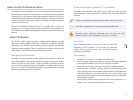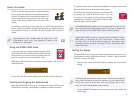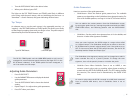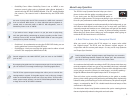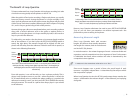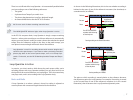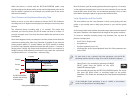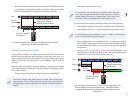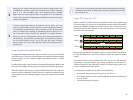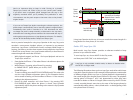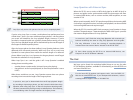
The Benefit of Loop Quantize
To better understand how Loop Quantize aids in phrase recording, let’s take
a look at how one typically records phrases on the RC-50.
When the guide’s off and you’re recording a Single mode phrase, you usually
have one primary concern: closing the phrase so it loops smoothly. If you
don’t close the phrase at exactly the right moment, the phrase will play with
a little “hiccup” each time it repeats. Mastering this skill is all part of Looping
101, and it’s easy to get the hang of with a little practice.
However, things get a bit more complicated when you’re recording a phrase
along with a musical reference such as the guide or another phrase. In
addition to closing the phrase so it loops smoothly by itself, it also needs to
loop in sync with the reference.
To achieve this, you need to close the phrase so its measure length matches
that of the reference. If you don’t press the REC/PLAY/OVERDUB pedal at
exactly the right place, the measure length will be slightly off and your
phrase will drift away from the reference a little bit each time it repeats, as
shown in the following illustration.
Play start
Phrase 2
Phrase 1
(reference)
Here, Phrase 2 was recorded in reference to Phrase 1, a one-measure phrase. However, it was
closed just a little late, creating a phrase slightly longer than Phrase 1. Even though they’ve
started playing at the same time, they fall out of sync with each other more with each
successive loop.
Even with practice, it can still be tricky to close a phrase perfectly. This is
where Loop Quantize comes to your aid—when the phrase is closed, the
RC-50 automatically trims or extends the phrase ending so it matches the
reference’s measures, even if you don’t press REC/PLAY/OVERDUB at exactly
the right moment. This results in a phrase that always plays in sync relative
to the reference.
Phrase 1
(reference)
Play start
Phrase 2
In this example, Phrase 2 was recorded in reference to Phrase 1, just as before. This time,
though, Loop Quantize was used to close the phrase, creating a measure length identical to
Phrase 1. As a result, the phrases stay in perfect sync relative to each other.
Because Loop Quantize eliminates the need to press REC/PLAY/OVERDUB
“just so,” you can focus your attentions on another important task—the
performance you’re recording in the phrase.
Measuring Measure Length
Since Loop Quantize deals with measure
lengths, let’s discuss what actually determines
the length of a measure, both in musical terms
and in the RC-50’s phrases.
In musical notation—the written language of music—measures divide and
organize a musical composition into short segments of time. Each measure
is subdivided into beats, whose number and value is determined by the
composition’s time signature.
A measure is also sometimes referred to as a “bar.”
Since music happens over a period of time, the actual length of each
measure—as played in elapsed time—is determined by the tempo at which
the composition is played.
When Loop Quantize is active, the RC-50’s patch tempo always matches the
tempo—and therefore the measure length—of the reference you’re playing
along with.
; ;
O
O O
O
; ;
O
O O
O




